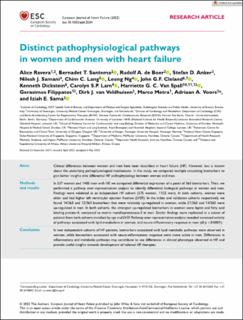| dc.contributor.author | Ravera, Alice | |
| dc.contributor.author | Santema, Bernadet T. | |
| dc.contributor.author | de Boer, Rudolf A. | |
| dc.contributor.author | Anker, Stefan D. | |
| dc.contributor.author | Samani, Nilesh J. | |
| dc.contributor.author | Lang, Chim C. | |
| dc.contributor.author | Ng, Leong | |
| dc.contributor.author | Cleland, John G.F. | |
| dc.contributor.author | Dickstein, Kenneth | |
| dc.contributor.author | Lam, Carolyn S.P. | |
| dc.contributor.author | Van Spall, Harriette G. C. | |
| dc.contributor.author | Filippatos, Gerasimos | |
| dc.contributor.author | van Veldhuisen, Dirk J. | |
| dc.contributor.author | Metra, Marco | |
| dc.contributor.author | Voors, Adriaan A. | |
| dc.contributor.author | Sama, Iziah E. | |
| dc.date.accessioned | 2022-09-14T09:39:04Z | |
| dc.date.available | 2022-09-14T09:39:04Z | |
| dc.date.created | 2022-09-07T14:26:04Z | |
| dc.date.issued | 2022 | |
| dc.identifier.issn | 1388-9842 | |
| dc.identifier.uri | https://hdl.handle.net/11250/3017757 | |
| dc.description.abstract | Aims: Clinical differences between women and men have been described in heart failure (HF). However, less is known about the underlying pathophysiological mechanisms. In this study, we compared multiple circulating biomarkers to gain better insights into differential HF pathophysiology between women and men.
Methods and results: In 537 women and 1485 men with HF, we compared differential expression of a panel of 363 biomarkers. Then, we performed a pathway over-representation analysis to identify differential biological pathways in women and men. Findings were validated in an independent HF cohort (575 women, 1123 men). In both cohorts, women were older and had higher left ventricular ejection fraction (LVEF). In the index and validation cohorts respectively, we found 14/363 and 12/363 biomarkers that were relatively up-regulated in women, while 21/363 and 14/363 were up-regulated in men. In both cohorts, the strongest up-regulated biomarkers in women were leptin and fatty acid binding protein-4, compared to matrix metalloproteinase-3 in men. Similar findings were replicated in a subset of patients from both cohorts matched by age and LVEF. Pathway over-representation analysis revealed increased activity of pathways associated with lipid metabolism in women, and neuro-inflammatory response in men (all p < 0.0001).
Conclusion: In two independent cohorts of HF patients, biomarkers associated with lipid metabolic pathways were observed in women, while biomarkers associated with neuro-inflammatory response were more active in men. Differences in inflammatory and metabolic pathways may contribute to sex differences in clinical phenotype observed in HF, and provide useful insights towards development of tailored HF therapies. | en_US |
| dc.language.iso | eng | en_US |
| dc.publisher | Wiley | en_US |
| dc.rights | Attribution-NonCommercial-NoDerivatives 4.0 Internasjonal | * |
| dc.rights.uri | http://creativecommons.org/licenses/by-nc-nd/4.0/deed.no | * |
| dc.title | Distinct pathophysiological pathways in women and men with heart failure | en_US |
| dc.type | Journal article | en_US |
| dc.type | Peer reviewed | en_US |
| dc.description.version | publishedVersion | en_US |
| dc.rights.holder | Copyright 2022 the authors | en_US |
| cristin.ispublished | true | |
| cristin.fulltext | original | |
| cristin.qualitycode | 2 | |
| dc.identifier.doi | 10.1002/ejhf.2534 | |
| dc.identifier.cristin | 2049548 | |
| dc.source.journal | European Journal of Heart Failure | en_US |
| dc.identifier.citation | European Journal of Heart Failure. 2022. | en_US |

